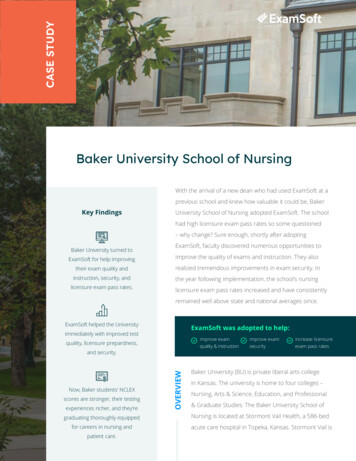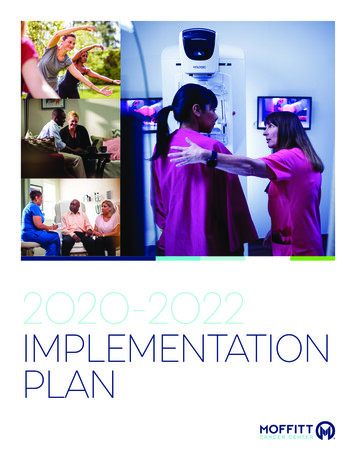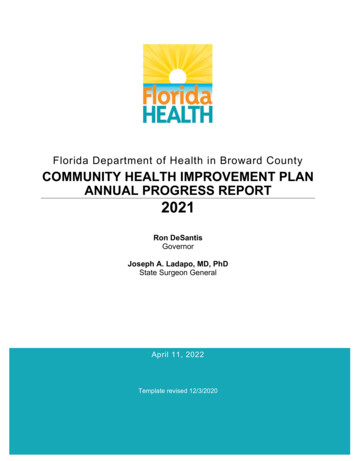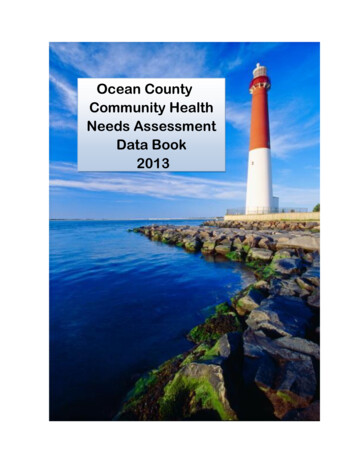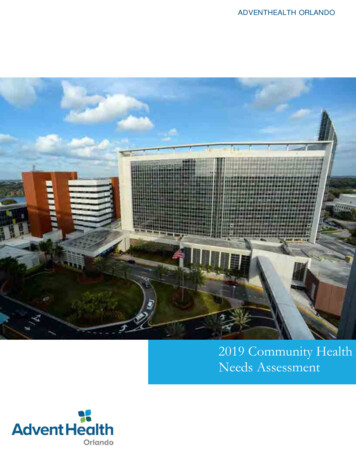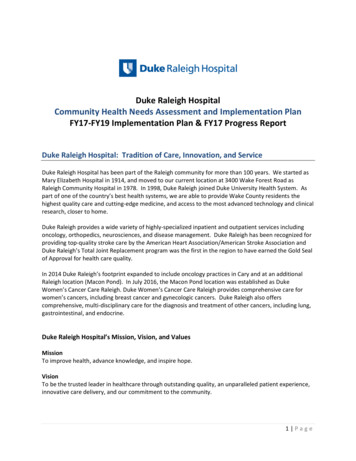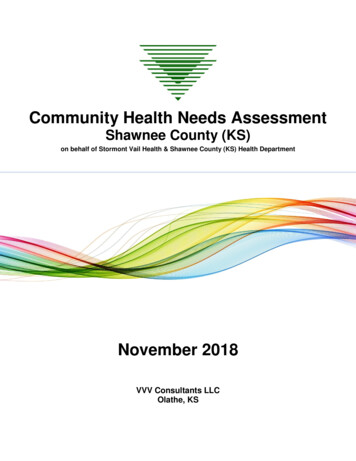
Transcription
Community Health Needs AssessmentShawnee County (KS)on behalf of Stormont Vail Health & Shawnee County (KS) Health DepartmentNovember 2018VVV Consultants LLCOlathe, KS
Community Health Needs AssessmentTable of ContentsI.Executive Summarya) Town Hall CHNA Findings: Areas of Strengths and Areas to Changeand/or Improveb) County Health Area of Future Focus (A prioritized description of all of thecommunity needs identified by the CHNA)II.Methodologya) CHNA Scope and Purposeb) Local Collaborating CHNA parties (The identity of any and allorganizations with which the organization collaborated and third partiesthat engaged to assist with the CHNA)c) CHNA and Town Hall Research Process (A description of the process andmethods used to conduct the CHNA, a description of how the organizationconsidered the input of persons representing the community and anexplanation of the process/ criteria used in prioritizing)d) Community Profile (A description of the community served by the facilityand how the community was determined)III.Community Health Statusa) Historical Community Health Statisticsb) Online Survey Community PerceptionsIV.Inventory of Existing County Health Resourcesa) A description of the existing health care facilities and other resourceswithin the community available to meet the needs identified through theCHNAV.Detail Exhibitsa) Patient Origin and Access to Careb) Town Hall Attendees, Notes and Feedback (Who attended withqualifications)c) Public CHNA Notice and Newsd) Primary Research Detail1
I. Executive SummaryShawnee County, Kansas - 2018 Community Health Needs Assessment (CHNA) WaveNo. 3Creating healthy communities requires a high level of mutual understanding and collaborationamong community leaders. The development of this assessment brings together communityhealth leaders and providers along with the local residents to research and prioritize countyhealth needs and document community health delivery success. This health assessment willserve as the foundation for community health improvement efforts for the next three years.Shawnee County, Kansas previous CHNA began in May 2015, with final report dated November2016. (Note: The Patient Protection and Affordable Care Act (ACA) requires not-for-profithospitals to conduct a CHNA every three years and adopt an implementation strategy to meetthe needs identified by the CHNA). Wave No. 3 Shawnee County, Kansas, CHNA assessmentbegan in May 2018 and was facilitated and created by VVV Consultants, LLC (Olathe, Kansas)staff under the direction of Vince Vandehaar, MBA.Important community CHNA benefits for both the local hospital and the health department,are: 1) Increases knowledge of community health needs and resources; 2) creates common understanding of thepriorities of the community’s health needs; 3) enhances relationships and mutual understanding between and amongstakeholders; 4) provides a basis upon which community stakeholders can make decisions about how they cancontribute to improving the health of the community; 5) provides rationale for current and potential funders to supportefforts to improve the health of the community; 6) creates opportunities for collaboration in delivery of services to thecommunity and; 7) provides guidance to the hospital and local health department for how they can align their servicesand community benefit programs to best meet needs, and; 8) fulfills hospital mission to deliver quality health care.A prioritized description of all of the community needs identified by CHNA activates arelisted below. Eight community health improvements needs have been identified.2
Shawnee County CHNA Town Hall also identified eighteenCommunity Health StrengthsKey CHNA Wave No. 3 secondary research conclusions are:KANSAS HEALTH RANKINGS: According to the 2018 Robert Woods Johnson County HealthRankings, Shawnee County Kansas was ranked fourth in clinical care and forty-seventh inmortality out of the 105 counties.TAB 1. Shawnee County’s population is 178,187, with a population density of 327.1 residentsper square mile. 6.4% of the population is under the age of 5, and 17.0% is over the age of 65.51.5% of Shawnee is Female. Hispanic and Latinos make up 12.0% of the population, and thereare 8.2% of Shawnee who speak a language other than English at home. Single parenthouseholds in Shawnee County are high at 33%. There are 14,510 veterans living in ShawneeCounty.TAB 2. The per capita income in Shawnee County is 27,534, with 10.9% of the population inpoverty. There are 80,074 total housing units with a severe housing problem of 14%. There are13,147 total firms in Shawnee County and an unemployment rate of 4.1%. Food insecurity is at14%, and low income and low access to a store is 9.5%.TAB 3. Children eligible for a free or reduced-price lunch are higher than average at 56%.91.1% of students graduate high school, and 29.3% of students earn their bachelor’s degree orhigher.TAB 4. The percent of births where prenatal care started in the first trimester is 78.5%. 81.4%infants in Shawnee County are receiving full immunization up to 24 months. Births occurring tounmarried women is 47.1%, higher than the average by 10%. Births where mothers havesmoked during the pregnancy is at 16.2%.3
ContinuedTAB 5. There is one primary care physician per 1,390 people in Shawnee County. 75% ofpatients would rate their hospital 9 or 10 out of 10. 79% of patients would recommend theirhospital. The average emergency room wait time is 24 minutes.TAB 6. People getting treated for depression in Shawnee County is 23.1%. The age-adjustedsuicide mortality rate in Shawnee County is 20.2.TAB 7. There are 35% of adults in Shawnee County that are obese, with 24% of the populationphysically inactive. 15% of adults drink excessively and 16% smoke. Hyperlipidemia inShawnee County is higher than the average, at 48.1% as well as Asthma at 9.0%.TAB 8. The adult uninsured rate for Shawnee County is 9%.TAB 9. Life expectancy in Shawnee County is 74.9 for males and 80.6 for females. The ageadjusted cancer mortality rate is high, at 180.8, as well as the heart disease mortality rate, at161.3. Alcohol impaired driving deaths is high, at 28%.TAB 10. 87% of Shawnee County has access to exercise opportunities. Only 68% of women inShawnee County get annual mammography screenings.Key 2018 Community Feedback Conclusions: Stakeholder feedback fromresidents, community leaders and providers (N 2324) provided the following communityinsights via an online perception survey: Using a Likert scale, 55.1% of Shawnee County stakeholders would rate the overallquality of health care delivery in their community as either very good or good.Shawnee County stakeholders are satisfied with the following services: ambulanceservices, chiropractors, eye doctor/optometrist, hospice, and pharmacy.When considering past CHNA needs, mental health access; affordable health insurance,and poverty continue as ongoing problem and pressing issues.Shawnee Co CHNA Wave No. 3 Ongoing ProblemEvaluate Past CHNAs health needsRankTopic1Mental Health Access2Affordable Health Insurance3Poverty4Drug / Substance Abuse5Obesity6Substance Abuse7Alcohol Abuse8Wellness / PreventionPressing NowShawnee Co Shawnee Co Shawnee CoShawnee CoZips onlyOnlineZips onlyOnline N 2324N 1206N 2324N 1206Votes %Votes Awareness of Existing HC Services10Primary Care Access5.4%5.3%5.3%5.4%11Chronic Health5.3%5.4%8812Nutrition - Healthy Food Options13Fitness / Exercise Options5.3%4.3%5.3%4.3%1114111414Personal Health Management15Teenage 4
II. Methodology[VVV Consultants LLC]5
II. Methodologya) CHNA Scope and PurposeThe federal Patient Protection and Affordable Care Act (ACA) requires that each registered501(c)3 hospital conduct a Community Health Needs Assessment (CHNA) at least once everythree years and adopt a strategy to meet community health needs. Any hospital who has filed a990 is required to conduct a CHNA. IRS Notice 2011-52 was released in late fall of 2011 to givenotice and request comments.JOB #1: Meet/Report IRS 990 Required Documentation1. A description of the community served by the facility and how the community wasdetermined;2. A description of the process and methods used to conduct the CHNA;3. The identity of any and all organizations with which the organization collaborated andthird parties that it engaged to assist with the CHNA;4. A description of how the organization considered the input of persons representingthe community (e.g., through meetings, focus groups, interviews, etc.), who thosepersons are, and their qualifications;5. A prioritized description of all of the community needs identified by the CHNA and anexplanation of the process and criteria used in prioritizing such needs; and6. A description of the existing health care facilities and other resources within thecommunity available to meet the needs identified through the CHNA.Section 501(r) provides that a CHNA must take into account input from persons who represent the broad interests ofthe community served by the hospital facility, including individuals with special knowledge of or expertise in publichealth. Under the Notice, the persons consulted must also include: Government agencies with current informationrelevant to the health needs of the community and representatives or members in the community that are medicallyunderserved, low-income, minority populations, and populations with chronic disease needs. In addition, a hospitalorganization may seek input from other individuals and organizations located in or serving the hospital facility’sdefined community (e.g., health care consumer advocates, academic experts, private businesses, health insuranceand managed care organizations, etc.).JOB #2: Making a CHNA Widely Available to the PublicThe Notice provides that a CHNA will be considered to be “conducted” in the taxable year thatthe written report of the CHNA findings is made widely available to the public. The Notice alsoindicates that the IRS intends to pattern its rules for making a CHNA “widely available to thepublic” after the rules currently in effect for Form 990. Accordingly, an organization would makea facility’s written report widely available by posting the final report on its website either in theform of (1) the report itself, in a readily accessible format or (2) a link to another organization’swebsite, along with instructions for accessing the report on that website. The Notice clarifies thatan organization must post the CHNA for each facility until the date on which its subsequentCHNA for that facility is posted.6
JOB #3: Adopt an Implementation Strategy by HospitalSection 501(r) requires a hospital organization to adopt an implementation strategy to meet theneeds identified through each CHNA. The Notice defines an “implementation strategy” as awritten plan that addresses each of the needs identified in a CHNA by either (1) describing howthe facility plans to meet the health need or (2) identifying the health need as one that the facilitydoes not intend to meet and explaining why the facility does not intend to meet it. A hospitalorganization may develop an implementation strategy in collaboration with other organizations,which must be identified in the implementation strategy. As with the CHNA, a hospitalorganization that operates multiple hospital facilities must have a separate writtenimplementation strategy for each of its facilities.Great emphasis has been given to work hand-in-hand with leaders from hospitals, the statehealth department and the local health department. A common approach has been adopted tocreate the CHNA, leading to aligned implementation plans and community reporting.7
IRS Notice 2011-52 OverviewNotice and Request for Comments Regarding the Community Health NeedsAssessment Requirements for Tax-exempt HospitalsApplicability of CHNA Requirements to “Hospital Organizations”The CHNA requirements apply to “hospital organizations,” which are defined in Section 501(r) to include(1) organizations that operate one or more state-licensed hospital facilities, and (2) any other organizationthat the Treasury Secretary determines is providing hospital care as its principal function or basis forexemption.How and When to Conduct a CHNAUnder Section 501(r), a hospital organization is required to conduct a CHNA for each of its hospitalfacilities once every three taxable years. The CHNA must take into account input from personsrepresenting the community served by the hospital facility and must be made widely available tothe public. The CHNA requirements are effective for taxable years beginning after March 23, 2012.As a result, a hospital organization with a June 30 fiscal year end must conduct an initial CHNA for eachof its hospital facilities by June 30, 2013, either during the fiscal year ending June 30, 2013 or duringeither of the two previous fiscal years.Determining the Community ServedA CHNA must identify and assess the health needs of the community served by the hospital facility.Although the Notice suggests that geographic location should be the primary basis for defining thecommunity served, it provides that the organization may also take into account the target populationsserved by the facility (e.g., children, women, or the aged) and/or the facility’s principal functions (e.g.,specialty area or targeted disease). A hospital organization, however, will not be permitted to define thecommunity served in a way that would effectively circumvent the CHNA requirements (e.g., by excludingmedically underserved populations, low-income persons, minority groups, or those with chronic diseaseneeds).Persons Representing the Community ServedSection 501(r) provides that a CHNA must take into account input from persons who represent thebroad interests of the community served by the hospital facility, including individuals with specialknowledge of or expertise in public health. Under the Notice, the persons consulted must also include:(1) government agencies with current information relevant to the health needs of the community and(2) representatives or members of medically underserved, low-income, and minority populations, andpopulations with chronic disease needs in the community. In addition, a hospital organization may seekinput from other individuals and organizations located in or serving the hospital facility’s definedcommunity (e.g., health care consumer advocates, academic experts, private businesses, healthinsurance and managed care organizations, etc).8
Required DocumentationThe Notice provides that a hospital organization will be required to separately document the CHNA foreach of its hospital facilities in a written report that includes the following information: 1) a description ofthe community served by the facility and how the community was determined; 2) a description of theprocess and methods used to conduct the CHNA; 3) the identity of any and all organizations with whichthe organization collaborated and third parties that it engaged to assist with the CHNA; 4) a description ofhow the organization considered the input of persons representing the community (e.g., throughmeetings, focus groups, interviews, etc.), who those persons are and their qualifications; 5) a prioritizeddescription of all of the community needs identified by the CHNA and an explanation of the process andcriteria used in prioritizing such needs; and 6) a description of the existing health care facilities and otherresources within the community available to meet the needs identified through the CHNA.Making a CHNA Widely Available to the PublicThe Notice provides that a CHNA will be considered to be “conducted” in the taxable year that the writtenreport of the CHNA findings is made widely available to the public. The Notice also indicates that theIRS intends to pattern its rules for making a CHNA “widely available to the public” after the rules currentlyin effect for Forms 990. Accordingly, an organization would make a facility’s written report widely availableby posting on its website either (1) the report itself, in a readily accessible format, or (2) a link to anotherorganization’s website, along with instructions for accessing the report on that website. The Noticeclarifies that an organization must post the CHNA for each facility until the date on which its subsequentCHNA for that facility is posted.How and When to Adopt an Implementation StrategySection 501(r) requires a hospital organization to adopt an implementation strategy to meet the needsidentified through each CHNA. The Notice defines an “implementation strategy” as a written planthat addresses each of the needs identified in a CHNA by either (1) describing how the facilityplans to meet the health need, or (2) identifying the health need as one that the facility does notintend to meet and explaining why the facility does not intend to meet it. A hospital organizationmay develop an implementation strategy in collaboration with other organizations, which must beidentified in the implementation strategy. As with the CHNA, a hospital organization that operates multiplehospital facilities must have a separate written implementation strategy for each of its facilities.Under the Notice, an implementation strategy is considered to be “adopted” on the date the strategy isapproved by the organization’s board of directors or by a committee of the board or other parties legallyauthorized by the board to act on its behalf. Further, the formal adoption of the implementation strategymust occur by the end of the same taxable year in which the written report of the CHNA findings wasmade available to the public. For hospital organizations with a June 30 fiscal year end, that effectivelymeans that the organization must complete and appropriately post its first CHNA no later than its fiscalyear ending June 30, 2013, and formally adopt a related implementation strategy by the end of the sametax year. This final requirement may come as a surprise to many charitable hospitals, considering Section501(r) contains no deadline for the adoption of the implementation strategy.9
IRS and Treasury Finalize Patient Protection Rules for Tax-ExemptHospitals ACCOUNTING TODAY 1/2/15The Internal Revenue Service and the Treasury Department have issued final regulationsunder the Affordable Care Act to protect patients in tax-exempt hospitals from aggressive debtcollection practices and to provide other rules for charitable hospitals.Under the final regulations, each Section 501(c)(3) hospital organization is required to meetfour general requirements on a facility-by-facility basis: establish written financial assistanceand emergency medical care policies; limit the amounts charged for emergency or othermedically necessary care to individuals eligible for assistance under the hospital's financialassistance policy; make reasonable efforts to determine whether an individual is eligible forassistance under the hospital’s financial assistance policy before engaging in extraordinarycollection actions against the individual; and conduct a community health needs assessment,or CHNA, and adopt an implementation strategy at least once every three years. The first threerequirements are effective for tax years beginning after March 23, 2010 and the CHNArequirements are effective for tax years beginning after March 23, 2012.The ACA also added a new Section 4959, which imposes an excise tax for failure to meet theCHNA requirements, and added reporting requirements. These final regulations provideguidance on the entities that must meet these requirements, the reporting obligations relatingto these requirements and the consequences for failing to satisfy the requirements.“Charitable hospitals represent more than half of the nation’s hospitals and play a key role inimproving the health of the communities they serve,” wrote Emily McMahon, Deputy AssistantSecretary for Tax Policy at the U.S. Department of the Treasury, in a blog post Mondayexplaining the requirements. “But reports that some charitable hospitals have usedaggressive debt collection practices, including allowing debt collectors to pursue collections inemergency rooms, have highlighted the need for clear rules to protect patients. For hospitalsto be tax-exempt, they should be held to a higher standard. That is why the Affordable CareAct included additional consumer protection requirements for charitable hospitals, so thatpatients are protected from abusive collections practices and have access to informationabout financial assistance at all tax-exempt hospitals.”She noted that as a condition of their tax-exempt status, charitable hospitals must take an activerole in improving the health of the communities they serve, establish billing and collectionsprotections for patients eligible for financial assistance, and provide patients with the informationthey need to apply for such assistance. “These final rules adopt the same framework ofproposed regulations but simplify the compliance process for charitable hospitals, whilecontinuing to provide meaningful guidance on protections for patients and requirements toassess community health needs,” she added.10
Under the new rules, hospitals cannot charge individuals eligible for financial assistance morefor emergency or other medically necessary care than the amounts generally billed to patientswith insurance (including Medicare, Medicaid, or private commercial insurance). In addition,every tax-exempt hospital must establish and widely publicize a financial assistance policy thatclearly describes to patients the eligibility criteria for obtaining financial assistance and themethod for applying for financial assistance.Charitable hospitals are also prohibited from engaging in certain collection methods (forexample, reporting a debt to a credit agency or garnishing wages) until they make reasonableefforts to determine whether an individual is eligible for assistance under the hospital’s financialassistance policy.In addition, each charitable hospital needs to conduct and publish a community health needsassessment at least once every three years and disclose on the tax form that it files on anannual basis the steps it is taking to address the health needs identified in the assessment.Many of the requirements have been in place since the Affordable Care Act passed in 2010, butin response to comments on the proposed regulations, the final rules also expand access totranslations for patients, by lowering the threshold for having translations of financial assistancepolicies available from 10 percent of the community served as proposed, to five percent of thecommunity served or population expected to be encountered by the hospital facility, or 1000persons, whichever is less, according to McMahon. “The final rules also revise the notificationrequirements to maintain important protections for patients while making it easier for hospitals tocomply with them,” she wrote. “General notifications regarding a hospital’s financial assistancepolicy must appear on bills and in the hospital. However, individual written and oral notifications ofthe hospital’s financial assistance policy are now only required when a hospital plans to useextraordinary collections actions, such as reporting a debt to a credit bureau, selling the debt to athird party or garnishing wages.”While charitable hospitals must continue to make a good-faith effort to comply, the rules providecharitable hospitals with time to fully update their policies and programming to implement thechanges. But if a charitable hospital fails to meet the consumer protection provisions required bythe law, the hospital could have its tax-exempt status revoked. If a hospital fails to properlyconduct a community health needs assessment or adopt an implementation strategy, an excisetax will apply, McMahon noted. “However, if a hospital fails to meet a requirement, but the failureis neither willful nor egregious, the hospital can correct and publicly disclose the error to have itexcused, thus avoiding revocation of tax-exempt status, but the excise tax would still apply,” shewrote.11
CHNA NEWS: IRS Makes First Revocation of HospitalNot-for-Profit Status Under 501(r)RICH DALY, HFM A SENIOR WRITER/EDITORAug. 15, 2017—Charity-care reporting requirements under the healthcare reform law may have gone intoeffect only last October, but already one hospital has lost its not-for-profit tax status as a result. The firsttime tax-status revocation under Affordable Care Act (ACA) 501(r) requirements applied to a “dual-status”501(c)(3) hospital operated by a “local county governmental agency” and was confirmed by a redactedcopy of the tax status letter, which was dated Feb. 14, 2017, and posted to the IRS website in August.Neither an IRS spokeswoman nor the redacted letter identified the hospital. Loss of the 501(c)(3)exemptions eliminates the ability of hospitals to use certain employee benefit plans; likely subjectshospitals to income, property, and other taxes; bars receipt of tax-deductible contributions; and disallowsuse of tax-exempt bonds.The 501(r) requirements on performing community health needs assessments (CHNAs) and offeringfinancial assistance became effective for tax years beginning on or after Dec. 29, 2015, meaning taxexempt hospitals operating on the calendar had to be in compliance by Jan. 1, 2016, and those with adifferent fiscal-year end had to be in compliance by Oct. 1, 2016.The only enforcement information previously released by the IRS was a June 2016 letter to Sen. CharlesGrassley (R-Iowa), which noted that at that point the IRS had completed 2,482 compliance reviews under501(r). Additionally, 163 hospitals were assigned for “examination” as a result of those compliancereviews, but no further actions were identified.The ACA requires the IRS to review the community-benefit activities of about 3,000 tax-exempt hospitalsat least once every three years. This was the first time that Keith Hearle, president, Verité HealthcareConsulting, LLC, Alexandria, Va., had heard of an instance in which a hospital lost its not-for profit statusover 501(r) requirements. He has heard of several others that incurred the 50,000 excise tax for failingto meet the CHNA requirement.“I would be surprised if it is a one-off,” said Hearle, who has been expecting more IRS enforcement afterhis own reviews indicated widespread hospital vulnerability due to poor compliance.Reasons for RevocationHospital 501(r) requirements include: Conducting a CHNA at least once every three years Making the CHNA publicly available on a website Adopting an implementation strategy to meet the needs identified in the CHNA Adopting a financial assistance policy and publicizing the policy, including by posting it on a website Limiting the amounts charged to individuals who are eligible for financial assistance Making individuals aware of the financial assistance policy prior to engaging in certain collectionactionsAmong the reasons for the IRS action against the county government hospital was its finding that thehospital did not make the CHNA widely available to the public through a website, although it had papercopies available on request. “The hospital indicated to the IRS that it might have acted on some of therecommendations included in the Implementation Strategy Report, but that a separate writtenimplementation policy was neither drafted nor adopted,” the IRS letter stated.12
Officials at the small rural hospital said they lacked the staffing to comply with 501(r) requirements. Theyalso said they “really did not need, actually have any use for, or want their tax-exempt status underSection 501(c)(3),” according to the IRS letter. The hospital believed its tax-exempt status somehowprevented its involvement in certain payment arrangements. It had maintained 501(c)(3) status “only incase any liabilities arose relating to the prior management company that had originally obtained thatstatus from the IRS.”The IRS deemed the hospital’s failure “egregious” because its leaders had “neither the will, the resources,nor the staff to follow through with the” 501(r) requirements.Widespread VulnerabilityIndustry advisers worry that many hospitals could be vulnerable to IRS enforcement—if not tax-statusrevocation—under the new requirements. “A lot of them just assume that what they have, in terms ofpolicy and procedure, suffices under the final regulations and have not done a lot,” said AndrewKloeckner, a partner for Omaha-based law firm Baird Holm.Even hospitals that have taken steps to become compliant with the requirements can face downsides,including complications with their collection efforts, which in turn can delay cash flow, Kloeckner said.Jan Smith, a tax senior manager in Crowe Horwath’s Healthcare practice, indicated that the likelihood ofa similar penalty or the likelihood of this determination setting a precedent at other hospitals may belimited. This is due to the unusual position taken by the revoked hospital’s officials that they didn’t needor want charitable status (in addition to governmental status).“If hospitals are making a good-faith effort to comply, I would be surprised if the IRS would revoke theirtax status at this stage of 501(r) examinations,” Smith said in an interview. However, she is aware ofseveral health systems that the IRS is seeking to penalize under the CHNA tax provision.The IRS’s 501(r) compliance reviews include the agency’s analysis of hospital websites and “otherinformation designed to identify the hospitals with the highest likelihood of non-compliance,” IRSCommissioner John Koskinen stated in his 2016 letter to Grassley.Justin Lowe, senior manager with the Exempt Organizations Tax Practice at Ernst & Young, underscoredthat hospital websites are among the
Shawnee County is higher than the average, at 48.1% as well as Asthma at 9.0%. TAB 8. The adult uninsured rate for Shawnee County is 9%. TAB 9. Life expectancy in Shawnee County is 74.9 for males and 80.6 for females. The age-adjusted cancer mortality rate is high, at 180.8, as well as the heart disease mortality rate, at 161.3.



